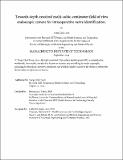Towards depth-resolved multi-cubic-centimeter field of view endoscopic camera for intraoperative nerve identification.
Author(s)
Yoon, Yong-Chul
DownloadThesis PDF (12.02Mb)
Advisor
Vakoc, Benjamin J.
Terms of use
Metadata
Show full item recordAbstract
One out of every five peripheral nerve injuries in the United States has an iatrogenic origin. These injuries can cause chronic neuropathies, paresthesia, and varying functional losses.
To reduce the risk of nerve injury, surgeons meticulously identify and track nerves within the surgical field using white-light magnification. However, small (sub-millimeter diameter)
and buried nerves are often difficult to identify with this approach. This has motivated a long-standing effort to develop improved nerve visualization technologies that are deployable in both open and minimally invasive surgical workflows. Fluorescence imaging is the most commonly explored strategy, and multiple exogenous fluorophores that bind to nerve-specific targets have been developed. However, fluorescence imaging has several limitations, including a disrupted workflow (due to the need for specialized lighting) and a significant regulatory burden. For these reasons, fluorescence-based nerve visualization has not yet been clinically adopted.
Polarization-based optical coherence tomography (OCT) approaches to nerve visualization would inherently mitigate each of these translational challenges. First, OCT imaging is not affected by room light and thus can be used simultaneously with surgical lighting. Second, OCT is label-free and avoids regulatory pathways associated with new drug development. However, because OCT offers high-resolution, three-dimensional imaging. A surgical OCT system supporting video-rate acquisition of cubic centimeter fields would require signal capture bandwidths that are several orders of magnitude higher than what is available today. It is unlikely that this gap will be addressed through incremental advances in existing OCT platforms.
In this thesis, we present a radically different OCT platform designed to aggressively reduce signal capture bandwidths while also simplifying the optical and electronic subsystem designs. The proposed approach is contour-looping (CL-) OCT (pronounced cloaked). It retains the depth-sectioning capability upon which OCT is based but discards the requirement of comprehensive three-dimensional imaging, which results in impractical signal capture bandwidths. As such, CL-OCT defines a strategy for low-bandwidth depth-sectioned imaging that may be sufficient for specific imaging tasks such as nerve identification. Importantly, the CL-OCT platform is compatible with a camera-based (i.e., scan-free) deployment that is advantageous for endoscopic deployments. In the second component of this thesis, we provide extensive theoretical and experimental studies on how optical amplifiers can be used in OCT to address sensitivity challenges of high-speed surgical OCT platforms like CL-OCT. Together, these lines of research define a new approach to meeting the need for OCT-based solutions for intraoperative nerve identification. This technology, if successfully translated, may lead to a lower incidence of iatrogenic nerve injury.
Date issued
2024-09Department
Harvard-MIT Program in Health Sciences and TechnologyPublisher
Massachusetts Institute of Technology